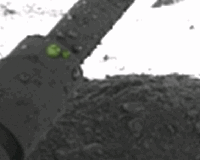The Phoenix lander's 2008 Mars observations of droplets on its legs and evidence of atmospheric exchange with liquid water
Until 2008, most scientists thought that there was no possibility of liquid water on Mars for any length of time in the current conditions there. However, in 2008 through to 2009, droplets were observed on the landing legs of Phoenix.
Unfortunately, it wasn't equipped to analyse them but the leading theory is that these were droplets of salty water.[1] They were observed to grow, darken and coalesce[2], and then disappear, presumably as a result of falling off the legs.
These may have formed on mixtures of salt and ice that were thrown up onto its legs when it landed. Experiments by Nilton Renno's team in 2014 in Mars simulation chambers show that water can form droplets readily in Mars conditions on the interface between ice and calcium perchlorate salts. The droplets can form within minutes in Mars simulation conditions. This is the easiest way they have found to explain the observations.[3][4]
Phoenix isotope evidence of liquid water on the Mars surface in the recent geological past
Phoenix also made isotopic measurements of the carbon and oxygen atoms in the atmospheric CO2 in the atmosphere. These measurements show that the oxygen has exchanged chemically with some liquid on the surface, probably water, in the recent geological past.[5][6] This gives indirect but strong evidence that liquid water exists on the surface or has existed, in the very recent geological past.
In detail, first they found that the ratio of isotopes for 13C to 12C in the atmosphere is similar to Earth. Mars should be enriched in 13C because the lighter 12C is lost to space, but isn't. So this shows that the CO2 must be continually replenished. So Mars must be geologically active at least from time to time in the recent geological past.
Then with the oxygen, their findings were the other way around. The CO2 is enriched in 18O compared with the 16O compared with CO2 as emitted from volcanic activity. They can make this deduction using information from meteorites from Mars, one of which was formed as recently as 160 million years ago. This shows that the oxygen in the CO2 in the atmosphere must have reacted chemically with water on the surface in order to take up heavier oxygen-18.
This research wasn't able to determine if this liquid water is episodic (e.g. after a meteorite strike) or continuously present. However their findings suggested that the exchange with the liquid water happened primarily at temperatures near freezing, which may rule out some hypotheses, particularly hydrothermal vent systems, as the primary source for the water.
- ↑ Cite error: Invalid
<ref>tag; no text was provided for refs namedphoenix_droplets_2009 - ↑ Staff writers, "The Salty Tears Of Phoenix Show Liquid Water On Mars", Mars Daily, Ann Arbor MI (SPX) Mar 19, 2009
- ↑ Cite error: Invalid
<ref>tag; no text was provided for refs namedsalt_ice - ↑ Cite error: Invalid
<ref>tag; no text was provided for refs namedsalt_ice_paper - ↑ Phoenix Mars Lander Finds Surprises About Planet’s Watery Past University of Arizona news, By Daniel Stolte, University Communications, and NASA's Jet Propulsion Laboratory | September 9, 2010
- ↑ Niles, P. B.; Boynton, W. V.; Hoffman, J. H.; Ming, D. W.; Hamara, D. (2010). "Stable Isotope Measurements of Martian Atmospheric CO2 at the Phoenix Landing Site" (PDF). Science. 329 (5997): 1334–1337. Bibcode:2010Sci...329.1334N. doi:10.1126/science.1192863. ISSN 0036-8075. PMID 20829484.
